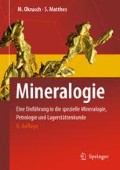Zusammenfassung
Zum Verständnis der Regeln, die bei der Kristallisation von Mineralen (Mineralparagenesen und Gesteinen) aus Silikatschmelzen herrschen, haben experimentelle Untersuchungen unschätzbare Beiträge geliefert. Solche Experimente wurden seit Beginn des 20. Jahrhunderts im Geophysical Laboratory der Carnegie Institution in Washington, D.C. (USA), später auch an anderen Instituten durchgeführt, und zwar zunächst an sehr einfachen Silikatsystemen unter trockenen Bedingungen und bei 1 bar Druck. Später erfolgten solche Untersuchungen an zunehmend komplizierteren Systemen oder natürlichen Gesteinen (s. Abschn. 14.3.2, S. 241f ) und bei viel höheren Drücken unter Anwesenheit leichtflüchtiger Komponenten, besonders H2O. Damit konnten auch die komplexeren, (OH)-haltigen gesteinsbildenden Minerale erfasst und dadurch die experimentellen Bedingungen den natürlichen Verhältnissen schrittweise angenähert werden. Selbstverständlich sind die experimentell gewonnenen petrologischen Modelle im Einzelfall nur mit kritischen Einschränkungen anwendbar, wobei wir grundsätzlich zwischen zwei Grenzfällen unterscheiden müssen, der Gleichgewichtskristallisation und der fraktionierten Kristallisation. Die Kristallisation eines Magmas in der Natur ist ein sehr komplexer Prozess, der noch dazu in viel größeren zeitlichen und räumlichen Dimensionen abläuft als im Experiment. Trotzdem konnten durch die experimentelle Petrologie Erkenntnisse von prinzipieller Bedeutung für das Verständnis der Bildung und Differentiation von Magmen gewonnen werden.
†Deceased
Access this chapter
Tax calculation will be finalised at checkout
Purchases are for personal use only
Preview
Unable to display preview. Download preview PDF.
Weiterführende Literatur
Morse SA (1980) Basalts and phase diagrams. Springer, New York Heidelberg Berlin
Sood MK (1981) Modern igneous petrology. Wiley, New York
Yoder HS (1976) Generation of basaltic magma. Nat Acad Sci, Washington/DC
Yoder HS (ed) (1979) The evolution of igneous rocks. Princeton Univ Press, Princeton, New Jersey
Yoder HS, Tilley CE (1962) Origin of basalt magmas: an experimental study of natural and synthetic rock systems. J Petrol 3:342–532
Zitierte Literatur
Atkins FB (1969) Pyroxenes of the Bushveld intrusion, South Africa. J Petrol 10:222–249
BoettcherAL,Burnham CW,Windom KE, Bohlen SR (1982) Liquids, glasses, and the melting of silicates to high pressures. J Geol 90:127–138
Bowen NL (1913) The melting phenomena of plagioclase feldspars. Am J Sci 185:577–599
Bowen NL (1914) The ternary system: Diopside–forsterite–silica. Am J Sci 188:207–264
Bowen NL (1915) The crystallization of haplobasaltic, haplodioritic and related magmas. Amer J Sci 190:161–185
Bowen NL (1928) The evolution of igneous rocks. Dover Publ, New York (Nachdruck 1956)
Bowen NL (1937) Recent high-temperature research and its significance in igneous geology. Am J Sci 233:1–21
Bowen NL, Andersen O (1914) The binary system MgO–SiO2. Am J Sci 187:487–500
Bowen NL, Schairer JF (1935) The system MgO–FeO–SiO2. Am J Sci 229:151–217
Bowen NL, Tuttle OF (1950) The system NaAlSi3O8–KAlSi3O8–H2O. J Geol 58:489–511
Boyd FR, England JL, Davis TC (1964) Effects of pressure on the melting and polymorphism of enstatite, MgSiO3. J Geophys Res 69:2101–2109
Boyd FR, Schairer JF (1964) The system MgSiO3–CaMgSi2O6. J Petrol 6:275–309
Correns CW (1968) Einführung in die Mineralogie, 2. Aufl (Nachdruck 1981). Springer, Berlin Heidelberg New York
Davis BTC, Schairer JF (1965) Melting relations in the join dioside– forsterite–pyrope at 40 kilobars and at one atmosphere. Carnegie Inst Washington Yearb 64:123–126
Ernst TH, Schorer G (1969) Die Pyroxene des „Maintrapps“, einer Gruppe tholeiitischer Basalte des Vogelsberges. Neues Jahrb Mineral Monatsh 1969:108–130
Goldsmith JR (1980) The melting and breakdown of plagioclase at high pressures and temperatures. Am Mineral 65:272–284
Goranson RW (1938) Silicate–water systems: Phase equilibria in the NaAlSi3O8–H2O and KAlSi3O8–H2O systems at high temperatures and pressures. Am J Sci 235A:71–91
Greig JW (1927) Immiscibility in silicate melts.Am J Sci 213:1–44, 133–154
Greig JW, Barth TWF (1938) The system Na2O·Al2O3·SiO2 (nepheline, carnegieite) – Na2O · Al2O3 · 6SiO2.Am J Sci (5) 235A:93–112
Kushiro I (1972) Determination of liquidus relations in synthetic silicate systems with electron probe analysis: The system forsterite–diopside–silica at 1 atmosphere.Am Mineral 57:1260–1271
Kushiro I (1973) The system diopside–anorthite–albite: Determination of compositions of coexisting phases. Carnegie Inst Washington Yearb 72:502–507
Kushiro I, Yoder HS (1969) Melting of forsterite and enstatite at high pressures under hydrous conditions. Carnegie Inst Wash Yearb 67:153–161
Lindsley DH (1966) Melting relations of KAlSi3O8: Effects of pressure up to 40 kilobars. Am Mineral 51:1793–1799
Lindsley DH (1968) Melting relations of plagioclase at high pressures. New York State Mus Sci Mem 18:39–46
Longhi J, Boudreau AE (1980) The orthoenstatite liquidus field in the system forsterite–diopside–silica at one atmosphere. Am Mineral 65:563–573
Morse SA (1968) Syenites. Carnegie Inst Washington Yearb 67:112–120
Morse SA (1970) Alkali feldspars with water at 5 kb pressure. J Petrol 11:221–251
Presnall DC (1969) The geometric analysis of partial fusion. Am J Sci 267:1178–1194
Schairer JF (1950) The alkali feldspar join in the system NaAlSiO4– KAlSiO4–SiO2. J Geol 58:512–517
Schairer JF, Bowen NL (1947) Melting relations in the systems Na2O–Al2O3–SiO2 and K2O–Al2O3–SiO2. Am J Sci 245:193–204
Schairer JF, Bowen NL (1955) The System K2O–Al2O3–SiO2. Am J Sci 253:681–746
Smith JV,Brown WL (1988) Feldspar minerals, vol 1, 2nd edn.Springer, Berlin Heidelberg New York
Tuttle OF, Bowen NL (1958) Origin of granite in the light of experimental data studies in the system NaAlSi3O8–KAlSi3O8–SiO2– H2O. Geol Soc America Mem 74:1–153
Wager LR, Brown GM (1968) Layered igneous rocks. Freeman, San Francisco
Yoder HS (1965) Diopside–anorthite–water at five and ten kilobars and its bearing on explosive volcanism. Carnegie Inst Wash Yearb 64:82–89
Yoder HS (1968) Albite–anorthite–quartz–water at 5 kb. Carnegie Inst Wash Yearb 66:477–478
Author information
Authors and Affiliations
Rights and permissions
Copyright information
© 2010 Springer-Verlag Berlin Heidelberg
About this chapter
Cite this chapter
Okrusch, M., Matthes †, S. (2010). Experimentelle Modellsysteme. In: Mineralogie. Springer-Lehrbuch. Springer, Berlin, Heidelberg. https://doi.org/10.1007/978-3-540-78201-8_16
Download citation
DOI: https://doi.org/10.1007/978-3-540-78201-8_16
Published:
Publisher Name: Springer, Berlin, Heidelberg
Print ISBN: 978-3-540-78200-1
Online ISBN: 978-3-540-78201-8
eBook Packages: Life Science and Basic Disciplines (German Language)

